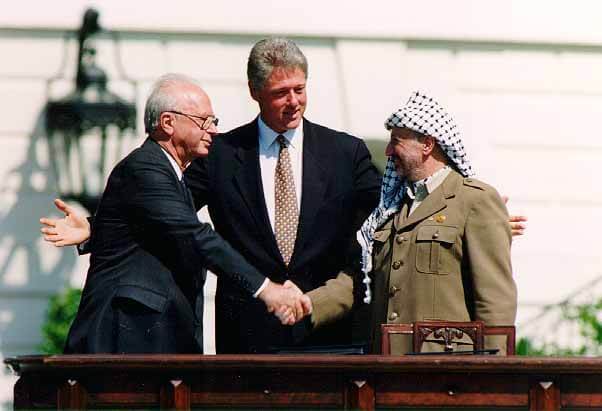On September 13, 1993, on the lawn of the White House, Israeli Prime Minister Yitzhak Rabin and Chairman of the Palestine Liberation Organization, Yasir Arafat, shook hands under the outstretched arms of President Bill Clinton. For many around the world, the image was iconic, representing a post-Cold War era of peace and global unity.
Thirty years later, the tatters of the Oslo Accords — built on a foundation of power imbalance, disregard for basic rights, and bad faith — are again iconic of a world whose very environment has eroded into a threat to humanity’s existence while the stratification of wealth and power and the resurgence of far-right ideologies have fueled tension and conflict across the globe, while placing huge obstacles in the path of desperately needed solutions.
On this 30th anniversary of Oslo, I’m reflecting on a time just a few years after that handshake. In 1997, I was an undergraduate and took on an independent research project on the Oslo Accords. The assignment was straightforward: simply review the Accords and offer a summary and assessment. I was to see if the agreements were politically viable and reasonable.
That paper is gone now, but I still remember the conclusions I reached. After a close read of the Declaration of Principles, the Gaza-Jericho Agreement, and the Interim Agreement, I was convinced that these agreements could not possibly lead to an end to the Israel-Palestine conflict.
A different era
When I reviewed the Oslo Accords for that paper, it was a very different time. This was before September 11, before the Second Intifada, before the greatest portions of Israel’s rightward lurch and its settlement expansions had occurred.
I was a different person in 1997 as well. I still believed that a Jewish state could be democratic. I had come a long way from my background, having grown up in a Jewish community that was not just Zionist but fiercely supportive of some of Zionism’s most extreme elements. I had spent many years researching the history of Israel and Palestine and learned a great deal about how much propaganda I had been fed. But I still did not understand just how brutally and, more importantly, willfully Zionism had dispossessed the Palestinian people. Part of it was that I had not yet studied the history and politics of the issue in an academic environment. More of it had to do with how little of what I had absorbed to that point had come from Palestinians.
The situation on the ground in Palestine was different then as well. The injustice and brutality of occupation and dispossession were, of course, well-established and already had a history of many decades. But there were fewer barriers between Israeli and Palestinian communities and no apartheid wall. Many more Palestinians came into Israeli towns and cities (although Israel had already begun phasing out Palestinian labor after the First Intifada had shown that this made Israel’s economy vulnerable to strikes by Palestinians), and Israelis would go to Palestinian towns, frequenting Palestinian businesses.
There was a sense among many Israelis and Palestinians, though far from all of them, that it was possible to work out difficult issues such as the Right of Return and Jerusalem, although that sense had already started to seriously erode, and each side had a very different vision of what “working it out” meant. Those views were dictated as much by the imbalance of power between Israelis and Palestinians as anything else.
Indeed, by 1997, a good deal of the hope of that handshake day had eroded, rotted away by Israel’s intentional bombing of a refugee camp at Qana in Lebanon, a string of suicide bombings carried out by Hamas and the Islamic Jihad, and Israel’s opening of a tunnel under the Haram al-Sharif/Temple Mount in 1996, among other issues.
Still, the sense that a solution could be found that allowed both Israelis and Palestinians to move forward was still alive, even if it was illusory.
A fatally flawed accord
So what was it that was so obvious even to a relatively inexperienced scholar, as I was in those days? What told me that the Oslo Accords could not possibly be the basis of a permanent agreement?
Several things were apparent to me, but perhaps the most striking and obvious one was the complete absence of any mention of human rights. This was an issue that I was aware of as I began my research, as the leading Palestinian scholar Edward Said had been making a very big deal of this point, highlighting it for a lot of the progressive media I was involved with at the time.
I actually went into the project hoping I could find something to counter this point. I did not doubt that Said was correct, but, I thought, maybe I could find something in the text that people of good will could latch onto to support the idea that basic human rights for all had to be a foundation for any agreement between Israelis and Palestinians, and that this notion was present in Oslo. I scoured the text for something I could use.
There was nothing, no hint of respect for universal human rights. To the extent that human rights were even implicitly addressed, it was strictly confined to policing and security agreements. The absence of human rights could not be an oversight, the product of a document written by elites who wanted to produce a legal, technical document and didn’t stop to consider the needs of the people. The careful avoidance of anything that might be used to invoke international humanitarian law, human rights law, or even principles reflected in the Universal Declaration of Human Rights had to be intentional.
Said was right, I discovered, and there was no way to mitigate it as I had hoped. But there was more missing.
Before I had even started the project, a fundamental flaw was obvious to any observer who was truly interested in an agreement that led to an end of Israeli domination over Palestinians. Arafat and Rabin had, several days before the White House handshake, exchanged letters. Arafat, in his letter, once again recognized Israel’s sovereignty and “right to exist…in peace and security.” In his letter, however, all Rabin granted Arafat was Israel’s recognition of the PLO as the “representative of the Palestinian people.”
Again, I scoured the text of the Accords for anything that affirmed the goal of a Palestinian state living in peace alongside Israel. Not a hint. Again, it was clear that this was intentionally avoided. In the context of the massive imbalance of power between Israel and the PLO, such omissions might have been expected, but they were precisely what needed to be guarded against if a bilateral agreement between such imbalanced parties could possibly be workable. Yet, there was no hint that this was ever considered in the drafting of these agreements. And that was not the end of it either.
There were no restrictions on settlement building. The closest the Accords came was the vague commitment that, “Neither side shall initiate or take any step that will change the status of the West Bank and the Gaza Strip pending the outcome of the permanent status negotiations.” That depended on the good faith of the Israeli side, since there was precious little the Palestinians could do to change the status of anything.
The United States had, I was aware, put some moderate pressure on Israel to rein in settlement expansion and, for a while, that kept that expansion limited. But it never stopped.
It was obvious that this would undermine negotiations and that, depending on American pressure on Israel — especially in an environment where both governments could change every few years — was a precarious endeavor. That U.S. moderation was such a key element was a predictably unreliable way to address the imbalance of power, although at the time, I, like many, couldn’t envision a better alternative. Still, even minor settlement expansion, on top of being a violation of international law, was clearly going to undermine faith in the process and lead to confrontations. One didn’t need to be an expert in the issue to understand that.
Fatal flaws don’t need hindsight
With Oslo now 30 years old and its failure obvious to all but the willfully blind, there are many analyses about what went wrong. But it’s important to recognize that this wasn’t a case of a carefully crafted, well-intentioned agreement that didn’t quite work out as intended. This was a deal that never stood a chance of success. And it didn’t require hindsight to know it. The naysayers like Prof. Said — naysayers who were mercilessly blasted in the press as being “anti-peace” — weren’t cynics who happened to be right. They were realists who saw the Accords for what they were.
It didn’t take much to realize that this was the case. All that was required was to read the actual text of the deals. In all fairness, most people weren’t going to do that unless they were paid for it. What’s more, the Oslo Accords struck me as being intentionally weighted with diplomatic word soup, making it even less appealing to a lay audience.
My own reading of it at the time was hardly an expert report. I was, at best, an informed amateur, and I point this out not to highlight my insight into the Accords. On the contrary, I say all this to point out how clear it was even in the 1990s that the Oslo Accords could not possibly bring about a positive outcome. It was obvious that an agreement that paid no attention to human rights, made no mention of a desired outcome — much less that it should be a Palestinian state — and completely ignored settlement expansion could not bring about a better future.
But that was not how the Accords were presented to the public — not in Israel, Palestine, the United States, Europe, or anywhere else.
The lessons to be drawn here are crucial. The media failed in its duty to thoroughly examine the Accords and the objections raised to them. We who have a relatively free press should demand better. The idea that Oslo was a noble but failed experiment lingers to this day, and it’s a thoroughly false narrative.
We should also learn from this to pay more careful attention to critics, especially those who are telling us things we may not want to hear. Because when critics of Oslo warned about the very thing I, as inexperienced as I was in 1997, could easily see for myself just by looking, they were derided. That’s not uncommon behavior, and it’s far from confined to the question of Palestine. There, and everywhere, Oslo should teach us to listen and react in a more thoughtful manner.



“Daniel Levy is President of the U.S./Middle East Project and served as an Israeli peace negotiator at the Oslo-B talks under Prime Minister Yitzhak Rabin and the Taba negotiations under Prime Minister Ehud Barak.” ( https://foreignpolicy.com/author/daniel-levy/ )
So let’s hear what he has to say about Oslo in this piece in OrientXXI, the website of Sylvain “The State of Israel Versus The Jews” Cypel: https://orientxxi.info/magazine/archetype-of-a-failure,6713
Levy has some criticism of the Palestinians, but –
But the tendency towards equal apportioning of blame is not only incorrect and largely irrelevant, it more fundamentally misses the point. Oslo was premised on terms convenient for, and largely set by, Israel. To have cemented that premise would have constituted a remarkable achievement for the Zionist Jewish State enterprise….Despite all the words spilled on the question of what went wrong with Oslo, one observation may suffice – that the only way the Oslo process as an Israeli construct could succeed would be for Israel to have gone the extra mile in making the terms of a settlement minimally palatable to a Palestinian leadership which had already crossed a major Rubicon in its readiness to compromise and which at the time carried sufficient legitimacy to seal a deal…Israel took what was, in objective terms, a too-much too-early Palestinian willingness to compromise and insisted on extracting endless concessions until there was no way back…That, in short, is the story of Oslo. Zionism was too hard-wired to not compromise, to entrench existential positions when it came to the Palestine question. In that respect, it is mistaken to extrapolate from Israel’s peace treaties with Jordan and Egypt an expectation of any reasonableness Israel might display in relations with the Palestinians….What we have today is the language of peace in the service of illegal actions, disenfranchisement, and apartheid.
Some thoughts.
Two events preceded Oslo (in the short term), the first intifada and the war in the gulf. Arafat backed Iraq in that war and that greatly weakened his position. In the aftermath of that war the Bush Baker foreign policy team was interested in movement in the middle east specifically on the Palestinian front, in a way that had not existed during Reagan’s term.
The election of Rabin was a bit of a fluke, in the 15 years after the election of Begin in 1977, the government had either been Likud or at times “a shared” government of Labor and Likud. So this outright premiership handed to Rabin and Labor was something unusual and thus “valuable” in terms of- must not be squandered, this was the view of the Labor voters.
Rabin was no dove regarding the Palestinians, but his party, his voters, wanted some movement on the Palestinian issue particularly because of the intifada. After the do nothing years of Shamir, Labor had taken the government and they expected action.
It is impossible to know Rabin’s precise thoughts as he went through the process of learning about the talks and approving the talks and achieving the interim agreements through these talks.
The interim nature of the agreements was meant to echo the interim agreement with Egypt. That withdrawal from Sinai (in 1975 against Rabin’s will) was a partial withdrawal and then was followed by a full withdrawal by Begin after Sadat’s trip to Jerusalem. Here on the Palestinian front, there was not really as clearly a half withdrawal from territory, but a half withdrawal from occupation. (If indeed the fraction was far less than half, that was not the point from the perspective of Rabin and his cabinet. They didn’t really trust Arafat and there was nothing really pressing causing this concession to political reality. It certainly was not a devotion to an immediate commitment to human rights. It was political reality and the need for Rabin to exhibit some creativity and initiative: some movement to differentiate between himself and Shamir was really the motivation.)
The interim agreement was designed as a first step, without much signed over, an opportunity to build trust for an actual agreement. On paper not much was conceded to the Palestinians.
Ultimately it was about the handshake between Rabin and Arafat, a personal commitment, that was based on a trust, but the trust was iffy. The assassination of Rabin made a big difference, but aside from the hatred from the right wing, the center had its doubts about the whole process. It would not have been easy for Rabin had he lived.
Clinton and Ehud Barak lacked the earnestness that Rabin brought to the process. I’m not sure what Barak wanted. I’m quite sure that Clinton was too diffuse (worried about his wife’s election to the Senate for one thing) to see what would be necessary to really get a final deal done.
The existence of this interim situation in perpetuity reflects the agreement on paper which was wobbly.